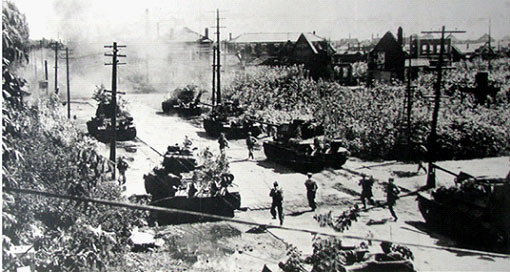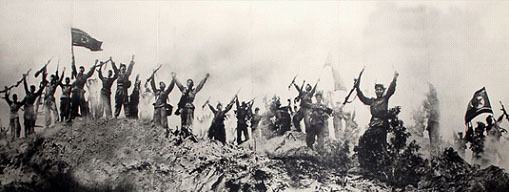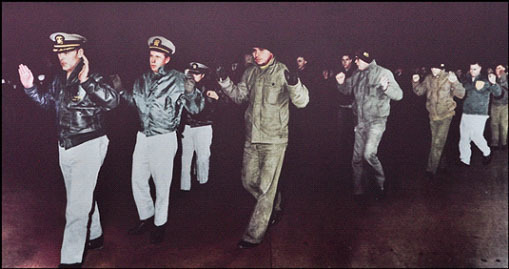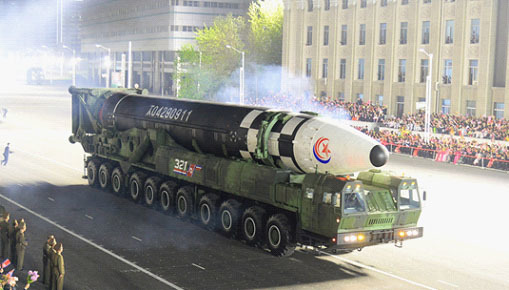
Smashing the Myth of the “Strongest”
On June 25, 1950, the United States unleashed an aggressive war in Korea in order to occupy its whole territory and thus provide a springboard for achieving its strategy of world supremacy. By abusing the name of the UN, it hurled into the Korean front one-third of its Army, one-fifth of its Air Force, most of its Pacific Fleet, some of its Mediterranean Fleet, troops of 15 of its satellite countries, the south Korean army and the remnants of the former Japanese army. It even resorted to nuclear blackmail.
At the time its might was regarded as a myth.
Compared to this, the Korean People’s Army was too young, no more than two years old after its founding (February 8, 1948). However, it repulsed the invasion by the allied imperialist forces on the strength of the original strategies and tactics advanced by Supreme Commander Kim Il Sung (1912-1994) and its spiritual and moral superiority and thus defended with honour the independence and sovereignty of the country.
Mark Clark, the then commander of the UN Forces, wrote later:

Under the command of Kim Il Sung, the KPA immediately switched over to a counterattack and liberated Seoul, the citadel of the enemy, on the third day of the outbreak of the war, encircled and annihilated through adroit manoeuvring the 24th Division of the US forces in Taejon, sank the US heavy cruiser Baltimore with four torpedo boats and shot down the enemy’s jet fighters with turbopropeller-powered aircraft; they were miracles wrought during the Korean war. And the aircraft-hunting team movement, formation of the second front with soldiers of the regular army, tunnel warfare and others were tactics alien to the US generals.
The KPA soldiers defended every inch of their country at the cost of blood by displaying mass heroism, even making a bayonet charge when the bullets ran out. Some of them blocked the enemy’s gun muzzles with their chests for the charge of their units.
The United States enlisted two-million-strong forces and latest military hardware during the three-year war, but suffered a human and material loss 2.3 times that it had suffered in the four-year war in the Pacific during the Second World War.
Frustrating the Enemy’s Military Provocations at Every Step
Since the Korean war was over, the DPRK has so far stood in confrontation with the United States.
The United States has committed one military provocation after another, but each time the KPA frustrated it.
A typical example is the capture of the Pueblo, an armed spy ship equipped with latest equipment. When it was committing acts of espionage in the territorial waters of the DPRK, the Navy of the KPA overpowered the resisting enemy sailors and captured it on January 23, 1968.
As it had one of its warships captured by another country for the first time in its history, the United States massed its troops including a carrier strike force around the Korean peninsula, forcing the DPRK to release the ship.

after intruding into the territorial waters of the DPRK) The DPRK, however, confronted the US provocative schemes by declaring its stand that it would meet the enemy’s “retaliation” with retaliation and return all-out war for “all-out war;” the service personnel occupied their combat posts, all set for a do-or-die fight, and the civilians engaged in their work with a rifle in one hand and a hammer or sickle in the other hand.
Daunted by its resolute stand, the US administration submitted a document of apology, which was as good as a document of surrender, and had only the crew return home.
In the subsequent confrontations with the United States, including the large US spy plane EC-121 incident in 1969, Panmunjom incident in 1976 and a US reconnaissance helicopter incident in 1994, the KPA always emerged victorious. In particular, in the latter half of the 1990s, when the country was experiencing extreme difficulties, the KPA, under the command of Chairman Kim Jong Il (1942-2011), not only defended socialism reliably by frustrating the schemes of the allied imperialist forces to ignite a war on the Korean peninsula but also played a decisive role in opening a wide avenue for building a powerful socialist country.

Today the KPA has become a world-class army, prepared politically and ideologically and possessed with state-of-the-art strategic and tactical weapons. It is guaranteeing the peaceful environment of the Korean peninsula, where an acute military confrontation still exists.
In August 2015 and in 2017 the United States and other hostile forces drove the Korean peninsula situation to a crisis. In those days the KPA took resolute countermeasures for the peace and security of the Korean peninsula and the surrounding region.
In 2022, when the United States and its vassal forces conducted several nuclear war games, clamouring for “strengthened offer of extended deterrent” and aggravating the situation in the peninsula.
At the time the KPA clearly demonstrated its supremacy and frustrated the enemy’s moves by taking large-scale military countermeasures–firing artillery of various calibres and launching tactical and strategic missiles and flying aircraft numbering hundreds.

The KPA will, in the future, too, reliably defend the peace and security of the Korean peninsula and the surrounding region.


